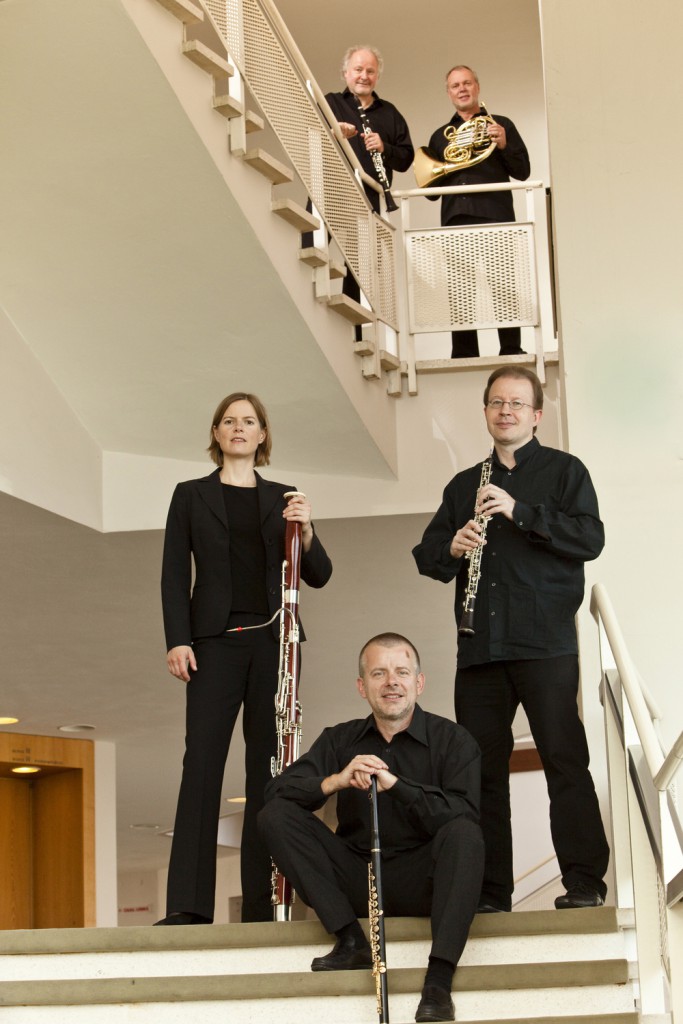Berlin Philharmonic Wind Quintet shows stellar artistry in well-balanced program

The Berlin Philharmonic Wind Quintet performed Friday night at Jordan Hall for the Celebrity Series.
The Berlin Philharmonic Wind Quintet has recently been exploring the music of Kalevi Aho. After encountering his First Wind Quintet ten years ago, the ensemble commissioned a second work and premiered it in Berlin in June 2015. Friday night at Jordan Hall, in a concert sponsored by the Celebrity Series, the Berlin Philharmonic Wind Quintet offered the new piece in its Boston premiere.
The Finnish composer is extraordinarily prolific, having completed sixteen symphonies and numerous concertos in addition to chamber works and operas. Recently his symphonic work Gejia received an acclaimed performance in Miami by Osmo Vänskä and the Minnesota Orchestra. Aho’s Second Wind Quintet is no less enthralling.
Aho describes the work as “like a symphony, just for five musicians.” Cast in four movements, the quintet is a marvel of form and dialogue. The first movement unfolds in a seamless arc that brims with searching melodies passed between English horn and bassoon. There are some color effects in the score—shrieking flute and oboe chords, stopped horn phrases, and flutter-tongue figures—but Aho does not overuse them. The second movement, entitled Virtuoso toccata, buzzes with energy. Darting figures pass between each instrument, and the musicians of the Berlin Philharmonic Wind Quintet handled them with dexterity.
Dark lyricism pervades the third movement, where eerie chords growl on the edge of a whisper. The finale sums up the piece with colorful dialogue between the instruments. It ends on a lonely note in the French horn as the other musicians puff air into their instruments. It’s an elemental conclusion to a work that stands as a fine contribution to wind quintet literature. The musicians performed the piece with bold commitment.
The Berlin Philharmonic Wind Quintet is perhaps the most polished wind ensemble in existence. The musicians play together with elegance and fine ensemble crispness. The most remarkable aspect of the ensemble’s playing is its cohesion. Instrumental lines color the musical textures in sumptuous blends. Indeed, the musicians are so seamless that they can practically finish each other’s sentences.
In Ligeti’s Six Bagatelles for Wind Quintet, also heard Friday night, the ensemble played with remarkable precision. The piece is one of clear, Mozartean textures with the occasional thorny harmonies that mark Stravinsky and Bartók’s music. In fact, the fifth bagatelle is in homage to the latter composer.
The musicians found the humor cast in these short pieces. Marion Reinhard’s bassoon blats that close a few of the movements drew laughs. The second piece’s lament was spacious, with the players shaping their phrases with subtle rubato touch. Textures were vivid. Soft chords hung in the air with a palpable intensity. Elsewhere, blaring dissonances dissolved into a warm consonance. The fourth bagatelle pulsed aggressively in its side-winding rhythm.
The musicians performed Ligeti’s music with crispness and vigor. Most beautiful was the third bagatelle, where a lyrical melody soared over frolicking figures. Flutist Michael Hasel, oboist Andreas Wittmann, and clarinetist Walter Seyfarth wove their sounds into an organ-like blend that seemed to glow at a distance.
The ensemble’s performance of Carl Nielsen’s Wind Quintet was similarly sensitive. As with Aho’s work, Nielsen’s quintet has a symphonic quality. Clear textures abound and sonorities from pairs of instruments blur together for soft colors. But above all this is chamber music at its finest, and Friday’s performance beamed with fine playing.
In the first movement, the ensemble performed with deft control of the work’s dynamic shading. Crescendos were long and uniform, with no single instrument peeking out of the texture. In the Menuetto, Seyfarth’s clarinet line burbled like a running brook. The concluding Prelude, Theme, and Variations, were studies in clarity. The musicians played the theme with hymn-like serenity and swelled their phrases to soulful heights when it returned at work’s end.
The variations showed off some of the players individually. Bassoonist Reinhard played her cadenza-like seventh variation with deep mahogany tone and fine control. French hornist Fergus McWilliam’s solo in the ninth variation had glowing warmth.
In the opener, the Berlin Philharmonic Wind Quintet made beautiful sounds from some of the simplest means. Mozart’s Fantasy in F minor for Mechanical Organ, K. 594, played in an arrangement by Michael Hasel, is a short work that is characteristically rife with melody. The second of the piece’s three movements bounced joyfully with the same crystalline edges that marked the other works on the program. But the beauty rested in the outer movements. There, the ensemble brought a mournful air and song-like grace to the music. Mozart, the musicians seemed to say, is forever a pure delight.
For encores, the musicians offered sweltering and swinging renditions of Gunther Schuller’s “Blues” from his Suite for Wind Quintet and Julio Medaglia’s tango El Porsche Negro.
The next Celebrity Series event will feature soprano Susanna Phillips and pianist Myra Huang 8 p.m. Saturday at Jordan Hall. celebrityseries.org; 617- 482-6661
Posted in Performances, Uncategorized



